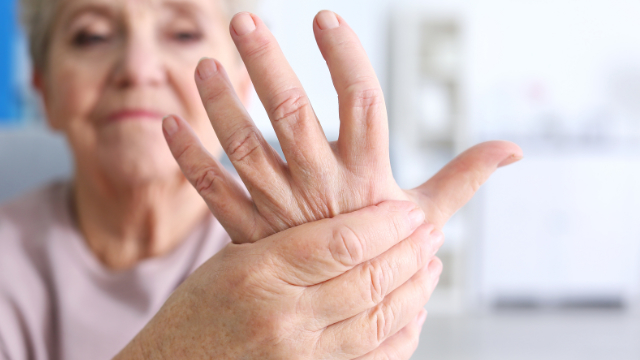
The term “arthritis” is used to describe more than 100 different conditions, all of which are defined by inflammation of one or more joints and a resulting set of bothersome symptoms. The exact cause in each case depends on what type of arthritis is present, but the common thread between them is a firm but flexible material tissue called cartilage. Cartilage normally surrounds the ends of bones in each joint to protect them and absorb shock, but problems can arise when it’s altered in any way.
In osteoarthritis, the most common type of arthritis, this protective cartilage gradually wears away over time due to age-related changes and several other factors. In rheumatoid arthritis, the cartilage erodes because the body’s immune system mistakenly identifies it as foreign and begins to attack it. Similar processes occur in all other types of arthritis as well, but the end result is always the same: after enough cartilage has worn away, the affected joint will no longer function normally.
Between pain, stiffness, and this reduced range of motion, most patients with arthritis begin to notice impairments in their daily lives and find that many otherwise simple tasks have become a challenge. Arthritis symptoms and the resulting amount of disability will of course vary depending its type and severity, but all patients will experience some difficulties functioning at one point or another. This brings up another similarity between all individuals with arthritis: a desire to make the pain go away.
How to alleviate arthritis symptoms on your own
Unfortunately, there is no cure for arthritis that will make cartilage grow back or completely stop the loss of it from occurring, but there are actually a number of steps you can take to reduce or eliminate your symptoms right now. Below are some of the best home remedies available. Consider discussing these options with your healthcare provider if you’re unfamiliar or have any questions:
- Bracing: wearing a brace is associated with a number of potential benefits for individuals with arthritis, such as enhanced stability, reduced swelling and pressure on the joint, and increased confidence when walking; braces help to shift bodyweight away from the damaged area of the affected joint, which alleviates pain and discomfort in the process; braces come in a variety of shapes, sizes, and styles, and are most commonly used for patients whose knees or ankles are affected by arthritis; talk to your doctor if you’re interested in wearing a brace for your arthritis
- Exercise: staying physically active is one of the best possible ways to treat arthritis symptoms, as it builds strength and improves the flexibility of joints; all forms of exercise can be helpful, but aquatic exercise is particularly recommended because it’s low impact and therefore does not put any added pressure on painful joints
- Hot and cold therapy: another simple home remedy is applying ice or heat to the affected joint when symptoms arise; cold therapy can reduce inflammation, swelling and pain, while heat can relax muscles and help lubricate joints, which can also relieve muscle and joint stiffness in the process; it’s often best to start with ice and then alternate with heat to maximize benefits
- Mobility devices: if your arthritis is severe enough, a device like a cane, walker, or wheelchair may be necessary to improve your mobility and allow you to get around on your own more easily; although this may be a difficult adjustment, it’s important to follow your doctor or physical therapist’s instructions and learn how to properly use your device in order to stay mobile
- Anti-inflammatory medications: some arthritis patients experience immediate joint pain relief from over-the-counter non-steroidal anti-inflammatory drugs (NSAIDs) like ibuprofen (Advil) and aspirin; talk to your doctor if you’re not sure if these drugs are right for you or how much/how frequently to take them
- Diet: lots of research has shown that what you eat can have a significant impact on the amount of inflammation present in your joints, and that eating anti-inflammatory foods can actually reduce inflammation and swelling responsible for arthritis symptoms; for example, the Mediterranean diet, which emphasizes lots of vegetables, whole grains, fish, and healthy fats, has been associated with lower levels of inflammation and may therefore be worth considering
- Physical therapy: if it feels like you’ve tried everything for your arthritis symptoms—including all the tips on this list—and your symptoms still haven’t gotten any better, it may be time to see a physical therapist for a comprehensive treatment program; ask your doctor for a referral or simply make an appointment on your own, since all states allow for some direct access to physical therapy
